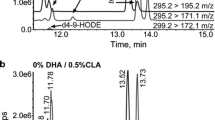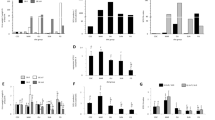Abstract
Conjugated linoleic acid (CLA) is a chemoprotective fatty acid that inhibits mammary, colon, forestomach, and skin carcinogenesis in experimental animals. We hypothesize that the ubiquitous chemoprotective actions of dietary CLA in extrahepatic tissues are dependent upon its role in modulating fatty acid composition and metabolism in liver, the major organ for lipid metabolism. This study begins to evaluate the role of CLA in lipid metabolism by determining the modulation of fatty acid composition by CLA. Female SENCAR mice were fed semipurified diets containing 0.0% (Diet A), 0.5% (Diet B), 1.0% (Diet C), or 1.5% (Diet D) CLA (by weight) for six weeks. Mice fed Diets B, C, and D exhibited lower body weights and elevated amounts of extractable total lipid in livers compared with mice fed diets without CLA (Diet A). Analyses of the fatty acid composition of liver by gas chromatography revealed that dietary CLA was incorporated into neutral and phospholipids at the expense of linoleate in Diets B, C, and D; oleate increased and arachidonate decreased in neutral lipids of CLA diet groups. In addition, increasing dietary CLA was associated with reduced linoleate in hepatic phospholipids. In an in vitro assay, CLA was desaturated to an unidentified 18:3 product to a similar extent as linoleate conversion to γ-linolenate (9.88, and 13.63%, respectively). These data suggest that CLA may affect metabolic interconversion of fatty acids in liver that may ultimately result in modified fatty acid composition and arachidonate-derived eicosanoid production in extrahepatic tissues. In addition to determining how dietary CLA modulates eicosanoid synthesis, further work is needed to identify enzymatic products that may result from desaturation of CLA.
Similar content being viewed by others
Abbreviations
- CLA:
-
conjugated linoleic acid
- FAME:
-
fatty acid methyl ester
- GC:
-
gas-liquid chromatography
- PUFA:
-
polyunsaturated fatty acid
References
Belury, M.A. (1995) Conjugated Dienoic Linoleate: A Polyunsaturated Fatty Acid with Unique Chemoprotective Properties, Nutr. Rev. 53, 83–89.
Belury, M.A., Nickel, K.P., Bird, C.E., and Wu, Y. (1996) Dietary Conjugated Linoleic Acid Modulation of Phorbol Ester Skin Tumor Promotion, Nutr. Cancer 26, 149–157.
Ip, C., Scimeca, J.A., and Thompson, H. (1995) Effect of Timing and Duration of Dietary Conjugated Dienoic Linoleic Acid on Mammary Cancer Prevention, Nutr. Cancer 24, 241–247.
Ip, C., Briggs, S.P., Haegele, A.D., Thompson, H., Storkson, J., and Scimeca, J.A. The Efficacy of Conjugated Linoleic Acid in Mammary Cancer Prevention Is Independent of Level or Type of Fat in the Diet, Carcinogenesis 17, 1045–1050.
Liew, C., Schut, H.A.J., Chin, S.F., Pariza, M.W., and Dashwood, R.H. (1995) Protection of Conjugated Linoleic Acid Against 2-Amino-3-Methylimidazo[4,5-F]Quinoline-Induced Colon Carcinogenesis in the F344 Rat: A Study of Inhibitory Mechanisms, Carcinogenesis 16, 3037–3044.
Chin, S.F., Liu, W., Storkson, J.M., Ha, Y.L., and Pariza, M.W. (1992) Dietary Sources of Conjugated Dienoic Isomers of Linoleic Acid, A Newly Recognized Class of Anticarcinogens, J. Food Comp. Anal. 5, 185–197.
Ip, C., Singh, M., Thompson, H.J., and Scimeca, J.A. (1994) Conjugated Linoleic Acid Suppresses Mammary Carcinogenesis and Proliferative Activity of the Mammary Gland in the Rat, Cancer Res. 54, 1212–1215.
Ip, C., Singh, M., Thompson, H.J., and Scimeca, J.A. (1991) Mammary Cancer Prevention by Conjugated Dienoic Derivative of Linoleic Acid, Cancer Res. 51, 6118–6124.
Ha, Y.L., Storkson, J., and Pariza, M.W. (1990) Inhibition of Benzo(A)Pyrene-Induced Mouse Forestomach Neoplasia by Conjugated Derivatives of Linoleic Acid, Cancer Res. 50, 1097–1101.
Abou-El-Ela, S.H., Prasse, K.W., Farrell R.L., Carroll, R.W., Wade, A.E., and Bunce, O.R. (1989) Effects of d,l-2-dinitrofluoromethylornithine and Indomethacin on Mammary Tumor Promotion in Rats Fed High n-3 and/or n-6 Diets, Cancer Res. 49, 1434–1440.
Bull, A.W., Bronstein, J.C., and Nigro, N.D. (1989) The Essential Fatty Acid Requirement for Azoxymethane-Induced Intestinal Carcinogenesis in Rats, Lipids 24, 340–346.
Fischer, S.M., Cameron, G.S., Baldwin, J.K., Jasheway, D.W., Patrick, K.E., and Belury, M.A. (1989) Arachidonic Acid Cascade and Multistage Carcinogenesis in Mouse Skin, in Skin Carcinogenesis: Mechanisms and Human Relevance (Slaga, T.J., Klein-Szanto, A.J.P., Boutwell, R.K., Spitzer, H.L., and D’Motto, B., eds.) pp. 249–264, Alan R. Liss, Inc., New York.
Banni, S., Day, B.W., Evans, R.W., Corongiu, F.P., and Lombardi, B. (1995) Detection of Conjugated Diene Isomers of Linoleic Acid in Liver Lipids of Rats Fed Choline-Deficient Diet Indicates That the Diet Does Not Cause Lipoperoxidation, J. Nutr. Biochem. 6, 281–289.
American Institute of Nutrition (1977) Report of the American Institute of Nutrition ad hoc Committee on Standards for Nutritional Studies, J. Nutr. 107, 1340–1348.
Bligh, E.G., and Dyer, W.J. (1959) A Rapid Method of Total Lipid Extraction and Purification, Can. J. Biochem. 37, 911–917.
Hamilton, J.G., and Comai, K. (1988) Rapid Separation of Neutral Lipids, Free Fatty Acids and Polar Lipids Using Pre-Packed Silica Sep-Pak Columns, Lipids 23, 1146–1149.
Shantha, N.C., Decker, E.A., and Hennig, B. (1993) Comparison of Methylation Methods for the Quantitation of Conjugated Linoleic Acid Isomers, J. Assoc. Off. Agri. Chem. 76, 644–649.
Belury, M.A., Lee, W.-Y., Lo, S., Locniskar, M., and Fischer, S.M. (1993) Dietary n-6 Fatty Acid Modulation of Phorbol Ester-Associated Events in Mouse Skin, Nutr. Cancer 19, 307–319.
Huang, Y.-C., Luedecke, L.O., and Shultz, T.D. (1994) Effect of Cheddar Cheese Consumption on Plasma Conjugated Linoleic Acid Concentrations in Men, Nutrition Res. 14, 373–386.
Leyton, J., Lee, M.L., Locniskar, M., Belury, M.A., Slaga, T.J., Bechtel, D., and Fischer, S.M. (1991) Effects of Dietary Fat on Phorbol Ester-Elicited Tumor Promotion and Other Events in Mouse Skin, Cancer Res. 51, 907–915.
Belury, M.A., Leyton, J.L., Patrick, K.E., Cumberland, A.G., Locniskar, M., and Fischer, S.M. (1991) Modulation of Phorbol Ester-Elicited Events in Mouse Epidermis by Dietary n-3 and n-6 Fatty Acids, Prostaglandins, Leukotrienes, Essent. Fatty Acids 44, 19–26.
Connor, T.P., Roebuck, B.D., Peterson, F.J., Lokesh, B., Kinsella, J.E., and Campbell, T.C. (1989) Effect of Dietary Omega-3 and Omega-6 Fatty Acids on Development of Azaserine-Incidence and Preneoplastic Lesions in Rat Pancreas, J. Natl. Cancer Inst. 81, 858–863.
Cook, M.E., Miller, C.C. Park, Y., and Pariza, M. (1993) Immune Modulation by Altered Nutrient Metabolism: Nutritional Control of Immune-Induced Growth Depression, Poultry Sci. 72, 1301–1305.
Chin, S.F., Storkson, J.M., Liu, W., Albright, K.J., and Pariza, M.W. (1994) Conjugated Linoleic Acid (9,11- and 10,12-octadecadienoic acid) Is Produced in Conventional But Not Germ-Free Rats Fed Linoleic Acid, J. Nutr. 124, 694–701.
Lee, K.N., Kritchevsky, D., and Pariza, M.W. (1994) Conjugated Linoleic Acid and Atherosclerosis in Rabbits, Atherosclerosis 108, 19–25.
Tugwood, J.D., Issemann, I., Anderson, R.G., Bundell, K.R., McPheat, W.L., and Green, S. (1992) The Mouse Peroxisome Proliferator Activated Receptor Recognizes a Response Element in the 5I Flanking Sequence of the Rat Acyl CoA Oxidase Gene, EMBO J. 11, 433–439.
Vanden Heuvel, J.P., Sterchele, P.F., Nesbit, D.J., and Peterson, R.E. (1993) Coordinate Induction of Acyl-CoA Binding Protein, Fatty Acid Binding Protein and Peroxisomal β-Oxidation by Peroxisome Proliferators, Biochim. Biophys. Acta 1177, 183–190.
Aldridge, T.C., Tugwood, J.D., and Green, S. (1995) Identification and Characterization of DNA Elements Implicated in the Regulation of CYP4A1 Transcription, Biochem. J. 306, 473–479.
Author information
Authors and Affiliations
About this article
Cite this article
Belury, M.A., Kempa-Steczko, A. Conjugated linoleic acid modulates hepatic lipid composition in mice. Lipids 32, 199–204 (1997). https://doi.org/10.1007/s11745-997-0025-0
Received:
Revised:
Accepted:
Issue Date:
DOI: https://doi.org/10.1007/s11745-997-0025-0




